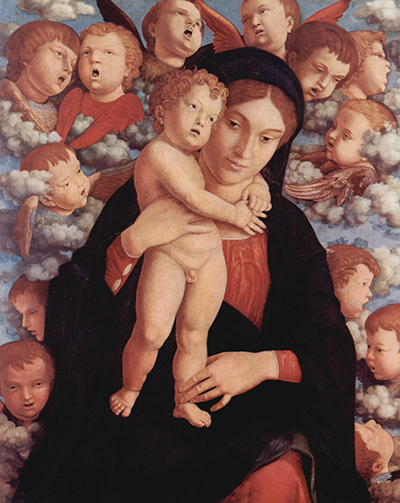Painted during the beginning of the Renaissance period in 1485, The Madonna of the Cherubim is considered one of Andrea Mantegna's most unusual pieces to date.
Throughout the entirety of the nineteenth century The Madonna of the Cherubim was accredited to his brother-in-law, Giovanni Bellini, because the brightness of the colours used and the Madonna's gentle expression. Though they both influenced each others artistry, Mantegna always favoured a methodical and intellectual approach over Bellini's emotional one. It was not until it was restored by Luigi Cavenaghi in 1885, that its attribution fell to its rightful owner.
It is unknown who the oil painting was original commissioned for exactly, yet some suggest it may have been the Duchess of Ferrara due to the Bellini-like face of the Madonna. However, it was situated at Chiesa di Santa Maria Maggiore in Venice until 1808, where it resided at the alter of the small convent. During the Napoleonic abolitions, Sansovino spotted this priceless Renaissance artefact and purchased for his own collection in Brera. Between the restoration by Cavenaghi in 1885 and its current residing at Pinacoteca di Brera in Milan, Italy, little is known of its location.
The Madonna of the Cherubim is made from panelling and tempera on wood. It appears to have once been part of a larger piece for it has been trimmed on either side of the painting. It consists of cherubim and seraphim surround the Madonna on either side distinguished by the colour of their wings; red and cream. Oil paint has been used to create this desired effect.
Mantegna's work, including The Madonna of the Cherubim inspired artists throughout the Renaissance period, even after his death in 1506. His experimentation of perspective, especially in this piece, allowed him to gain a new sense of quality that other artists at the time and after him tried to emulate. These included the aforementioned Bellini, Albrecht Dürer who reproduced several engravings in Germany and lastly, Leonardo da Vinci, who emulated Mantegna's use of decorations with festoons and fruit.




